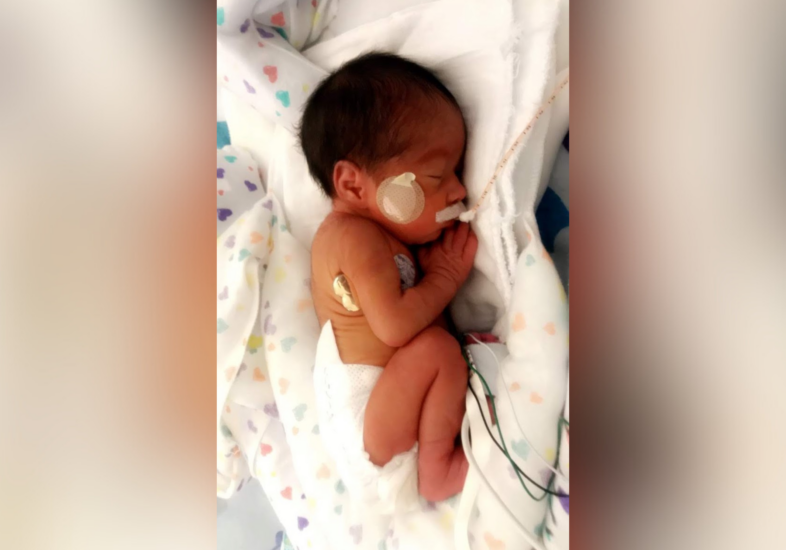When Yair Blumenfeld, MD, a maternal-fetal medicine specialist, receives a text message with a photo or video of Iliana, age 4, laughing, walking, and enjoying life, he shares it with his colleagues from the Fetal and Pregnancy Health Program at Lucile Packard Children’s Hospital Stanford who made it all possible. It makes everyone’s day. Ever since Iliana had fetal surgery, she has been defying the odds that often accompany her serious form of spina bifida.
Going the Distance
It was a selfless act by Iliana’s mother, Helisabed, to leave home in Southern California, undergo the surgery at Packard Children’s Hospital, and then stay near the hospital in the Ronald McDonald House at Stanford for months before and after delivery. Today, she is extremely glad that she did it.
“I had the chance to give my baby a better opportunity in life, and I took it,” says Helisabed.
At just 22 weeks into her pregnancy, she found out that her developing baby had the most serious form of spina bifida, called myelomeningocele. With fetal spina bifida, the spinal cord, or neural tube, doesn’t fully close, and it herniates through the backbone and into the amniotic cavity. An intact spinal cord is vital for movement, bodily functions, and brain health.
Helisabed learned that Packard Children’s Hospital could perform a cutting-edge in utero surgery to possibly save her baby from serious limitations later in life, proven successful in a national clinical trial called the Management of Myelomeningocele Study (MOMS). She underwent a rigorous process to qualify because not every mom and every fetus were candidates. When she was offered the surgery, she didn’t hesitate.
“She took on risks for herself in order to have the chance to benefit the baby,” says neurosurgeon Kelly Mahaney, MD.
The other option was waiting until after Iliana was born and then having surgery to close her spinal cord.
“When the spinal cord is open, there is a risk of meningitis, which is a life-threatening condition. That’s why when we perform a traditional repair of the neural tube defect, we do it a day or two after a baby is born,” Mahaney says.
The fetal surgery has had remarkable results. It requires opening the mother’s abdomen, draining the amniotic fluid from the uterus, and positioning the fetus so that its tiny spine faces the neurosurgeons. The surgeons then close the spinal cord defect, replace the amniotic fluid, and place unique sutures to create a watertight seal for the uterus before closing the mother’s abdomen.
According to the National Institute of Neurological Disorders and Stroke, the substantial majority of babies born with myelomeningocele need a shunt to continuously drain fluid from the brain, and most have leg weakness, experience changes in brain structure, and have bladder and bowel dysfunction. While Iliana needs leg braces to walk and a catheter to help drain her bladder, her brain and bowels work just fine. And she never needed a shunt.
“She wears leg braces because her feet turn inward, but she runs in them. Her teachers have to ask her to slow down. Plus she’s really smart. She loves school,” says Helisabed.
Iliana also loves the playground. She dives right in and challenges herself to climb steps and go up and down the slide. “She finds a way to do it all. Even if she has to sit on her bottom to get up steps, she does it,” Helisabed says.
When Helisabed takes Iliana to her spina bifida clinic in Orange County, California, for physical therapy, she walks away feeling extremely grateful to the doctors at Packard Children’s Hospital and proud of herself for undergoing the fetal surgery.
“There are kids in wheelchairs and kids with shunts. I can’t imagine how those moms do it,” she says. “Iliana has had a great outcome.”
Iliana’s outcomes are in line with or better than the overall findings of the MOMS study, where approximately 40% of babies who received prenatal surgery needed a shunt, compared with approximately 80% of babies who received the spinal closure surgery after birth. The MOMS study was so successful that it closed early, something that rarely ever happens.
While fetal surgery is done at a few hospitals besides Packard Children’s, Stanford is one of the only places in the United States that offers side-by-side expert care for both babies and mothers.
Children with spina bifida often need lifelong care to help them meet milestones and maintain bodily functions. That’s why Iliana sees doctors in her hometown to keep her walking on track. She also receives some support at school. When Iliana was an infant, Helisabed brought her to Stanford’s Spina Bifida Clinic, but it wasn’t feasible to stay, since she lives several hours away. But she understands the power of Iliana receiving ongoing care.
“She’s one of the brightest, happiest kids you will ever meet,” Helisabed says. “She shocks everyone with how well she is doing.”
Blumenfeld couldn’t be more pleased. He looks forward to photos of Iliana for years to come as she grows. “It’s a privilege and an honor to know that we were able to dramatically change her life,” he says.






